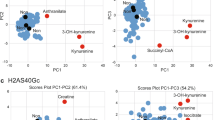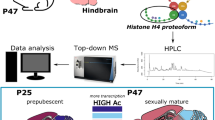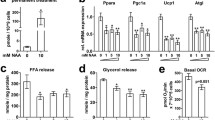Abstract
Little is known about the impact of metabolic stimuli on brain tissue at a molecular level. The ketone body beta-hydroxybutyrate (BHB) can be a signaling molecule regulating gene transcription. Thus, we assessed lysine beta-hydroxybutyrylation (K-bhb) levels in proteins extracted from the cerebral cortex of mice undergoing a ketogenic metabolic challenge (48 h fasting). We found that fasting enhanced K-bhb in a variety of proteins including histone H3. ChIP-seq experiments showed that K9 beta-hydroxybutyrylation of H3 (H3K9-bhb) was significantly enriched by fasting on more than 8000 DNA loci. Transcriptomic analysis showed that H3K9-bhb on enhancers and promoters correlated with active gene expression. One of the most enriched functional annotations both at the epigenetic and transcriptional level was “circadian rhythms''. Indeed, we found that the diurnal oscillation of specific transcripts was modulated by fasting at distinct zeitgeber times both in the cortex and suprachiasmatic nucleus. Moreover, specific changes in locomotor activity daily features were observed during re-feeding after 48-h fasting. Thus, our results suggest that fasting remarkably impinges on the cerebral cortex transcriptional and epigenetic landscape, and BHB acts as a powerful epigenetic molecule in the brain through direct and specific histone marks remodeling in neural tissue cells.







Similar content being viewed by others
Data availability
RNA-seq and ChIP-seq datasets generated and analyzed during this study are available on the GEO database: accession number GSE168725.
References
Gómez-Pinilla F (2008) Brain foods: the effects of nutrients on brain function. Nat Rev Neurosci 9:568–578
Mattson MP, Moehl K, Ghena N et al (2018) Intermittent metabolic switching, neuroplasticity and brain health. Nat Rev Neurosci 19:80–80
Tognini P, Samad M, Kinouchi K et al (2020) Reshaping circadian metabolism in the suprachiasmatic nucleus and prefrontal cortex by nutritional challenge. Proc Natl Acad Sci USA 117:29904–29913
Padamsey Z, Katsanevaki D, Dupuy N, Rochefort NL (2022) Neocortex saves energy by reducing coding precision during food scarcity. Neuron 110:280-296.e10
Dixon JB, Browne JL, Lambert GW et al (2013) Severely obese people with diabetes experience impaired emotional well-being associated with socioeconomic disadvantage: results from diabetes MILES—Australia. Diabetes Res Clin Pract 101:131–140
Dutheil S, Ota KT, Wohleb ES et al (2016) High-fat diet induced anxiety and anhedonia: impact on brain homeostasis and inflammation. Neuropsychopharmacology 41:1874–1887
Walsh ME, Shi Y, Van Remmen H (2014) The effects of dietary restriction on oxidative stress in rodents. Free Radical Biol Med 66:88–99
Luo H, Chiang H-H, Louw M et al (2017) Nutrient sensing and the oxidative stress response. Trends Endocrinol Metab 28:449–460
Lutas A, Yellen G (2013) The ketogenic diet: metabolic influences on brain excitability and epilepsy. Trends Neurosci 36:32–40
Evangeliou A, Vlachonikolis I, Mihailidou H et al (2003) Application of a ketogenic diet in children with autistic behavior: pilot study. J Child Neurol 18:113–118
Li Q, Liang J, Fu N et al (2021) A ketogenic diet and the treatment of autism spectrum disorder. Front Pediatr 9:650624
van der Louw E, van der Louw E, van den Hurk D et al (2016) Ketogenic diet guidelines for infants with refractory epilepsy. Eur J Paediatr Neurol 20:798–809
Paoli A, Rubini A, Volek JS, Grimaldi KA (2013) Beyond weight loss: a review of the therapeutic uses of very-low-carbohydrate (ketogenic) diets. Eur J Clin Nutr 67:789–796
Murakami M, Tognini P (2022) Molecular mechanisms underlying the bioactive properties of a ketogenic diet. Nutrients. https://doi.org/10.3390/nu14040782
Lee J, Duan W, Mattson MP (2002) Evidence that brain-derived neurotrophic factor is required for basal neurogenesis and mediates, in part, the enhancement of neurogenesis by dietary restriction in the hippocampus of adult mice. J Neurochem 82:1367–1375
Vivar C, Potter MC, Choi J et al (2012) Monosynaptic inputs to new neurons in the dentate gyrus. Nat Commun 3:1107
Landry T, Huang H (2021) Mini review: The relationship between energy status and adult hippocampal neurogenesis. Neurosci Lett 765:136261
Pizzorusso T, Tognini P (2020) Interplay between metabolism, nutrition and epigenetics in shaping brain DNA methylation, neural function and behavior. Genes. https://doi.org/10.3390/genes11070742
Newman JC, Verdin E (2014) Ketone bodies as signaling metabolites. Trends Endocrinol Metab 25:42–52
Kimura I, Inoue D, Maeda T et al (2011) Short-chain fatty acids and ketones directly regulate sympathetic nervous system via G protein-coupled receptor 41 (GPR41). Proc Natl Acad Sci 108:8030–8035
Taggart AKP, Kero J, Gan X et al (2005) (d)-β-Hydroxybutyrate inhibits adipocyte lipolysis via the nicotinic acid receptor PUMA-G. J Biol Chem 280:26649–26652
Won Y-J, Lu VB, Puhl HL 3rd, Ikeda SR (2013) β-Hydroxybutyrate modulates N-type calcium channels in rat sympathetic neurons by acting as an agonist for the G-protein-coupled receptor FFA3. J Neurosci 33:19314–19325
Shimazu T, Hirschey MD, Newman J et al (2013) Suppression of oxidative stress by β-hydroxybutyrate, an endogenous histone deacetylase inhibitor. Science 339:211–214
Tognini P, Murakami M, Liu Y et al (2017) Distinct circadian signatures in liver and gut clocks revealed by ketogenic diet. Cell Metab 26:523-538.e5
Xie Z, Zhang D, Chung D et al (2016) Metabolic regulation of gene expression by histone lysine β-hydroxybutyrylation. Mol Cell 62:194–206
Hashimoto T, Cook WS, Qi C et al (2000) Defect in peroxisome proliferator-activated receptor alpha-inducible fatty acid oxidation determines the severity of hepatic steatosis in response to fasting. J Biol Chem 275:28918–28928
Koubi HE, Robin JP, Dewasmes G et al (1991) Fasting-induced rise in locomotor activity in rats coincides with increased protein utilization. Physiol Behav 50:337–343
Koronowski KB, Greco CM, Huang H et al (2021) Ketogenesis impact on liver metabolism revealed by proteomics of lysine β-hydroxybutyrylation. Cell Rep 36:109487
Kobayashi Y, Ye Z, Hensch TK (2015) Clock genes control cortical critical period timing. Neuron 86:264–275
Pizzorusso T, Medini P, Berardi N et al (2002) Reactivation of ocular dominance plasticity in the adult visual cortex. Science 298:1248–1251
Wu D, Smyth GK (2012) Camera: a competitive gene set test accounting for inter-gene correlation. Nucleic Acids Res 40:e133–e133
Guo JU, Ma DK, Mo H et al (2011) Neuronal activity modifies the DNA methylation landscape in the adult brain. Nat Neurosci 14:1345–1351
Choi M, Wang SE, Ko SY et al (2014) Overexpression of human GATA-1 and GATA-2 interferes with spine formation and produces depressive behavior in rats. PLoS ONE 9:e109253
Li Z, Cogswell M, Hixson K et al (2018) Nuclear Respiratory Factor 1 (NRF-1) controls the activity dependent transcription of the GABA-A receptor beta 1 subunit gene in neurons. Front Mol Neurosci 11:285
Pereira JD, Sansom SN, Smith J et al (2010) Ezh2, the histone methyltransferase of PRC2, regulates the balance between self-renewal and differentiation in the cerebral cortex. Proc Natl Acad Sci U S A 107:15957–15962
Swiss VA, Casaccia P (2010) Cell-context specific role of the E2F/Rb pathway in development and disease. Glia 58:377–390
Veyrac A, Besnard A, Caboche J et al (2014) The transcription factor Zif268/Egr1, brain plasticity, and memory. Prog Mol Biol Transl Sci 122:89–129
Martin KC, Barad M, Kandel ER (2000) Local protein synthesis and its role in synapse-specific plasticity. Curr Opin Neurobiol 10:587–592
Hartsock MJ, Spencer RL (2020) Memory and the circadian system: identifying candidate mechanisms by which local clocks in the brain may regulate synaptic plasticity. Neurosci Biobehav Rev 118:134–162
Kinouchi K, Magnan C, Ceglia N et al (2018) Fasting imparts a switch to alternative daily pathways in liver and muscle. Cell Rep 25:3299-3314.e6
Vollmers C, Gill S, DiTacchio L et al (2009) Time of feeding and the intrinsic circadian clock drive rhythms in hepatic gene expression. Proc Natl Acad Sci USA 106:21453–21458
Mujica-Parodi LR, Amgalan A, Sultan SF et al (2020) Diet modulates brain network stability, a biomarker for brain aging, in young adults. Proc Natl Acad Sci USA 117:6170–6177
Yang H, Shan W, Zhu F et al (2019) Ketone bodies in neurological diseases: focus on neuroprotection and underlying mechanisms. Front Neurol 10:585
Simeone TA, Simeone KA, Rho JM (2017) Ketone bodies as anti-seizure agents. Neurochem Res 42:2011–2018
Stephan JS, Sleiman SF (2021) Exercise factors released by the liver, muscle, and bones have promising therapeutic potential for stroke. Front Neurol 12:600365
Sleiman SF, Henry J, Al-Haddad R et al (2016) Exercise promotes the expression of brain derived neurotrophic factor (BDNF) through the action of the ketone body β-hydroxybutyrate. Elife. https://doi.org/10.7554/eLife.15092
Chen L, Miao Z, Xu X (2017) β-hydroxybutyrate alleviates depressive behaviors in mice possibly by increasing the histone3-lysine9-β-hydroxybutyrylation. Biochem Biophys Res Commun 490:117–122
Rahman M, Muhammad S, Khan MA, et al (2014) The β-hydroxybutyrate receptor HCA2 activates a neuroprotective subset of macrophages. Nat Commun 5:3944
Yin J, Han P, Tang Z et al (2015) Sirtuin 3 mediates neuroprotection of ketones against ischemic stroke. J Cereb Blood Flow Metab 35:1783–1789
Telese F, Gamliel A, Skowronska-Krawczyk D et al (2013) “Seq-ing” insights into the epigenetics of neuronal gene regulation. Neuron 77:606–623
Zarrinpar A, Chaix A, Panda S (2016) Daily eating patterns and their impact on health and disease. Trends Endocrinol Metab 27:69–83
Tognini P, Murakami M, Sassone-Corsi P (2018) Interplay between microbes and the circadian clock. Cold Spring Harb Perspect Biol. https://doi.org/10.1101/cshperspect.a028365
Eckel-Mahan K, Sassone-Corsi P (2013) Epigenetic regulation of the molecular clockwork. Prog Mol Biol Transl Sci 119:29–50
Cajigas IJ, Will T, Schuman EM (2010) Protein homeostasis and synaptic plasticity. EMBO J 29:2746–2752
Lupori L, Cornuti S, Mazziotti R, et al (2022) The gut microbiota of environmentally enriched mice regulates visual cortical plasticity. Cell Rep 38:110212
Mottolese R, Redouté J, Costes N et al (2014) Switching brain serotonin with oxytocin. Proc Natl Acad Sci U S A 111:8637–8642
Yamasue H, Domes G (2018) Oxytocin and autism spectrum disorders. Curr Top Behav Neurosci 35:449–465
Borroto-Escuela DO, Ambrogini P, Chruścicka B et al (2021) The role of central serotonin neurons and 5-HT heteroreceptor complexes in the pathophysiology of depression: a historical perspective and future prospects. Int J Mol Sci. https://doi.org/10.3390/ijms22041927
Weiss O, Dorfman A, Ram T et al (2017) Rats do not eat alone in public: Food-deprived rats socialize rather than competing for baits. PLoS ONE 12:e0173302
Zhang X, Cao R, Niu J et al (2019) Molecular basis for hierarchical histone de-β-hydroxybutyrylation by SIRT3. Cell Discov 5:35
Verdin E, Hirschey MD, Finley LWS, Haigis MC (2010) Sirtuin regulation of mitochondria: energy production, apoptosis, and signaling. Trends Biochem Sci 35:669–675
Bao J, Lu Z, Joseph JJ et al (2010) Characterization of the murine SIRT3 mitochondrial localization sequence and comparison of mitochondrial enrichment and deacetylase activity of long and short SIRT3 isoforms. J Cell Biochem 110:238–247
Cooper HM, Spelbrink JN (2008) The human SIRT3 protein deacetylase is exclusively mitochondrial. Biochem J 411:279–285
Hallows WC, Albaugh BN, Denu JM (2008) Where in the cell is SIRT3?—functional localization of an NAD-dependent protein deacetylase. Biochem J 411:e11–e13
Huang H, Zhang D, Weng Y et al (2021) The regulatory enzymes and protein substrates for the lysine β-hydroxybutyrylation pathway. Sci Adv. https://doi.org/10.1126/sciadv.abe2771
Chirichella M, Lisi S, Fantini M et al (2017) Post-translational selective intracellular silencing of acetylated proteins with de novo selected intrabodies. Nat Methods 14:279–282
Patterson RE, Sears DD (2017) Metabolic effects of intermittent fasting. Annu Rev Nutr 37:371–393
Sa-Nguanmoo P, Tanajak P, Kerdphoo S et al (2016) FGF21 improves cognition by restored synaptic plasticity, dendritic spine density, brain mitochondrial function and cell apoptosis in obese-insulin resistant male rats. Horm Behav 85:86–95
Ferrario CR, Reagan LP (2018) Insulin-mediated synaptic plasticity in the CNS: anatomical, functional and temporal contexts. Neuropharmacology 136:182–191
Silva B, Mantha OL, Schor J et al (2022) Glia fuel neurons with locally synthesized ketone bodies to sustain memory under starvation. Nat Metab 4:213–224
Baldi P, Long AD (2001) A Bayesian framework for the analysis of microarray expression data: regularized t -test and statistical inferences of gene changes. Bioinformatics 17:509–519
Kayala MA, Baldi P (2012) Cyber-T web server: differential analysis of high-throughput data. Nucleic Acids Res 40:W553–W559
Acknowledgements
We thank Manuel Tongiani, Andrea Tognozzi, Matteo Alberti and Maria Grazia Giuliano for their help with the experiments. Special thanks to Vania Liverani and Antonella Calvello (Scuola Normale Superiore) for technical assistance in the lab. We thank Prof. Concetta Morrone and Prof. Paola Binda (University of Pisa) for their insightful comments.
Funding
This research was supported by H2020-MSCA-IF-2016 749697 GaMePLAY, University of Pisa PRA-2020, Italian Ministry of University and Research PNRR Tuscany Health Ecosystem Milestone 8.9.1 and PNRR young MSCA_0000081 iNsPIReD to PT, and funded in part by EFSD-Lilly 2019 to AG and PT. The work of SCh, MS, CM, and PB was in part supported by NIH Grant GM123558 to PB. RM was supported by Fondazione Umberto Veronesi.
Author information
Authors and Affiliations
Contributions
SC performed the experiments, analyzed the data, and prepared the figures. SCh performed the ChIP-seq and RNA-seq analysis. LL performed the daily activity analysis. FF and SR performed the Beta-hydroxybutyrilome analysis. FC, SF and AG performed the LC–MS-QTOF experiments and analysis. MS performed the RNA seq analysis. MC and FD helped with tissue harvesting and performed qPCR. FR helped with GO analysis. RM helped with correlations between ChIP-seq and RNA-seq. CM helped with ChIP-seq data alignment and analysis. PB supervised the RNA-seq and ChiP-seq data analysis. PT conceived and supervised the project, performed the experiments, and wrote the manuscript.
Corresponding author
Ethics declarations
Conflict of interest
The authors have no relevant financial or non-financial interests to disclose.
Ethics approval
All experiments were carried out in accordance with the European Directives (2010/63/EU) and were approved by the Italian Ministry of Health (authorization number 354/2020-PR).
Additional information
Publisher's Note
Springer Nature remains neutral with regard to jurisdictional claims in published maps and institutional affiliations.
Supplementary Information
Below is the link to the electronic supplementary material.
Rights and permissions
Springer Nature or its licensor (e.g. a society or other partner) holds exclusive rights to this article under a publishing agreement with the author(s) or other rightsholder(s); author self-archiving of the accepted manuscript version of this article is solely governed by the terms of such publishing agreement and applicable law.
About this article
Cite this article
Cornuti, S., Chen, S., Lupori, L. et al. Brain histone beta-hydroxybutyrylation couples metabolism with gene expression. Cell. Mol. Life Sci. 80, 28 (2023). https://doi.org/10.1007/s00018-022-04673-9
Received:
Revised:
Accepted:
Published:
DOI: https://doi.org/10.1007/s00018-022-04673-9




